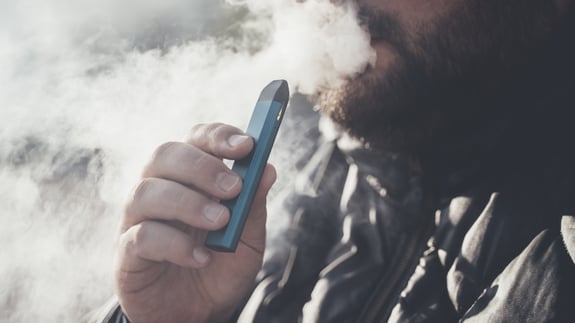
E-Cigarettes & Vaping
Nicotine can affect you physically and mentally, as well as damage the planet. Vaping can mean throwing away your health. Consider the real risks of vaping.
THE RISKS OF VAPING
Use of tobacco products, including e-cigarettes, in the United States is one of the most common causes of preventable disease, disability and death.
Vaping can be detrimental to the health of those who vape, people around those who vape and the planet. Children and young adults are especially vulnerable to loss of brain function as a result of vaping. Even using e-cigarette devices without nicotine can cause damage.
For those who vape, it can lead to lasting effects like:
- Bad Breath
-
Shortness of Breath
-
Higher Cancer Risk
-
Higher Risk of Lung Disease
-
Less Responsive Immune System
-
Decreased Brain Function in Developing Minds
-
Increased Mental Health Concerns (Such as Anxiety, Stress and Depression)
-
Nicotine Addiction
-
Increased Risk of Future Addiction to Other Drugs
- — Youth Vaping
- — Brain Damage
- — Heart & Lungs
- — Oral Problems
- — Immune System
- — How to Get Help
YOUTH VAPING
Vaping is an epidemic that puts kids, teens and young adults at risk. There are a million ways to teach about addiction, nicotine and the harmful effects of vaping. The risks are not worth the hit. One puff can lead to a nasty nicotine addiction, damage to your brain function, lung or heart disease, tooth decay and more.
Learn more about tobacco use in middle school or in young adults.
BRAIN DAMAGE
Did you know that your brain continues to develop until the age of 25? During this time in life, the brain is super vulnerable. This means that kids and teens are at an increased risk of suffering the lifelong effects of tobacco.
These effects are irreversible and can cause:
- Difficulty learning
- Decreased memory
- Increased risk of substance abuse
- Anxiety
- Depression
- Suicidal tendencies
- Nicotine dependency
- Decreased impulse control
- And more
HEART & LUNGS
Inhaling aerosols from a vape pen poses a serious threat to your lung health. “Fun” flavors can be extra risky. Along with the possibility of inhaling nicotine, there is a slew of chemicals in aerosol that can be harmful, according to the American Lung Association.
Many ingredients in e-cigarettes — even those without nicotine — are toxic and can cause damage to your lungs. These are just some of the emissions that can be detrimental:
- Ultrafine particles
- Acetaldehyde and formaldehyde — cause lung disease and heart disease
- Diacetyl — linked to lung disease
- Volatile organic compounds like benzene — found in car exhaust
- Acrolein — a weedkiller that can cause lung injury, COPD, asthma and lung cancer
- Heavy metals like nickel, tin and lead
You may even increase your risk of heart disease to the same level as a commercial cigarette. Most people with this disease are much older, but you could experience them much sooner by vaping. Blood flow to your heart may end up lower than that of traditional smokers, according to the American Heart Association.
Contracting heart or lung disease could mean losing your life.
ORAL PROBLEMS
Vaping puts you at a higher risk of experiencing symptoms like these:
- Dry mouth — which leads to bad breath, sores and tooth decay
- Periodontal disease — which damages gums and can damage the jaw
- Cavities — which may come from acidity in vape juice
- Tooth and bone loss
- Receding gums
43% of e-cigarette users,
73% of smokers
& 28% of non-tobacco users...
... in the United States have gum disease and oral infections.
IMMUNE SYSTEM
White blood cells called neutrophils make up 50-70 percent of your white blood cells, and they play a huge role in fighting off illness. Even without nicotine, e-cigarette vapor has been proven to interfere with the effectiveness of white blood cells.
When exposed to this vapor, the affected white blood cells have a slower response to fighting infections. They also lose the ability to produce the necessary chemicals to complete their task. That makes you more vulnerable to diseases like COVID-19, the flu and more. Teens and young adults may be five times more likely to test positive for COVID-19 if they have vaped.
HOW TO GET HELP
There's nothing wrong with asking for help.
The best way to stop vaping or to get help for someone else is to talk to a trusted adult like a parent, guardian, teacher or other family member. Healthcare professionals can be even more helpful.
Bring up the situation, explain the problem and let them know your feelings on the matter. Speak calmly, and answer any questions they may have.
Then don't wait to get help if you need it.
STARTLING STATS
These devices are creating a new generation of smokers with serious health problems. E-cigarettes are not safe for youth or adults. Check out these statistics:

Quit Today
People who use Quitline Coach are 2x more likely to quit and stay QUIT!
Connect with a Quitline Coach Today
STARTLING STATS
These devices are creating a new generation of smokers with serious health

Fact
In 2022, 1 of 7 high school students reported that they used e-cigarettes in the last month.

Fact
From 2011 to 2019, use of e-cigarettes among South Dakota middle schoolers rose from 2% to 16%.

Fact
In 2019, nearly 78% of South Dakota middle schoolers reported their source of e-cigarettes was family or friends.
ARE YOU ADDICTED?
- You feel the need to vape when you first wake up and throughout the day.
- You feel withdrawal symptoms like anxiousness and irritability when you don’t vape.
- You have a habit of reaching for your e-cigarette without thinking about it.
- Your day is interrupted by thoughts of vaping.
- You struggle to concentrate or sleep.
Quit & Stay Quit
Everybody quits differently. Your quit journey is your own, and only you know what works for you. Find the method that fits into your journey to put out that cigarette, shut off the vape pen or close the tin for the last time. Start your quit journey today, and get back to your life!
Read MorePhone Coaching
Get help from a Quitline phone coach. Your coach will be there for you every step of the way.
Get StartedKickstart Kit
Kick the habit with the FREE Kickstart Kit, which ships to your door with cessation medication and the Quit Guide.
Get Your KitQuit Guide
Skip the coaching and medication for now. Start your journey with the FREE Quit Guide to quit when you are ready.
Get the GuideAdults
Adults
Whether you are a parent, a pregnant or postpartum woman or a senior, learn more about the threat of tobacco.
Youth
Youth
Let's clear the air. Tobacco can affect you physically and mentally. Don't throw away your health for an addiction.
Native
Native
Smoking tobacco stifles traditions. Keep nicotine from your lungs to save more breath for telling your story.









